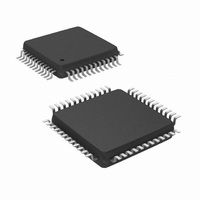DP83848CVVX/NOPB National Semiconductor, DP83848CVVX/NOPB Datasheet - Page 22

DP83848CVVX/NOPB
Manufacturer Part Number
DP83848CVVX/NOPB
Description
TXRX ETHERNET PHYTER 48-LQFP
Manufacturer
National Semiconductor
Type
Transceiverr
Datasheet
1.DP83848CVVXNOPB.pdf
(84 pages)
Specifications of DP83848CVVX/NOPB
Number Of Drivers/receivers
1/1
Protocol
Ethernet
Voltage - Supply
3 V ~ 3.6 V
Mounting Type
Surface Mount
Package / Case
48-LQFP
For Use With
DP83848C-POE-EK - BOARD EVALUATION DP83848CDP83848C-MAU-EK - BOARD EVALUATION DP83848C
Lead Free Status / RoHS Status
Lead free / RoHS Compliant
Other names
DP83848CVVX
Available stocks
Company
Part Number
Manufacturer
Quantity
Price
Company:
Part Number:
DP83848CVVX/NOPB
Manufacturer:
MICROCHIP
Quantity:
1 000
Company:
Part Number:
DP83848CVVX/NOPB
Manufacturer:
TI
Quantity:
107
Company:
Part Number:
DP83848CVVX/NOPB
Manufacturer:
NS
Quantity:
4 000
Company:
Part Number:
DP83848CVVX/NOPB
Manufacturer:
TI/NS
Quantity:
7
Company:
Part Number:
DP83848CVVX/NOPB
Manufacturer:
Texas Instruments
Quantity:
10 000
Part Number:
DP83848CVVX/NOPB
Manufacturer:
TI/德州仪器
Quantity:
20 000
www.national.com
To tolerate potential frequency differences between the 50
MHz reference clock and the recovered receive clock, the
receive RMII function includes a programmable elasticity
buffer. The elasticity buffer is programmable to minimize
propagation delay based on expected packet size and
clock accuracy. This allows for supporting a range of
packet sizes including jumbo frames.
3.3 10 Mb Serial Network Interface (SNI)
The DP83848C incorporates a 10 Mb Serial Network Inter-
face (SNI) which allows a simple serial data interface for 10
Mb only devices. This is also referred to as a 7-wire inter-
face. While there is no defined standard for this interface, it
is based on early 10 Mb physical layer devices. Data is
clocked serially at 10 MHz using separate transmit and
receive paths. The following pins are used in SNI mode:
— TX_CLK
— TX_EN
— TXD[0]
— RX_CLK
— RXD[0]
— CRS
— COL
3.4 802.3u MII Serial Management Interface
3.4.1 Serial Management Register Access
The serial management MII specification defines a set of
thirty-two 16-bit status and control registers that are acces-
sible through the management interface pins MDC and
MDIO. The DP83848C implements all the required MII reg-
isters as well as several optional registers. These registers
are fully described in Section 7.0. A description of the serial
management access protocol follows.
3.4.2 Serial Management Access Protocol
The serial control interface consists of two pins, Manage-
ment Data Clock (MDC) and Management Data Input/Out-
put (MDIO). MDC has a maximum clock rate of 25 MHz
and no minimum rate. The MDIO line is bi-directional and
may be shared by up to 32 devices. The MDIO frame for-
mat is shown below in Table 5.
Start Threshold
3 (12-bits)
0 (16-bits)
RBR[1:0]
1 (4-bits)
2 (8-bits)
Table 4. Supported packet sizes at +/-50ppm +/-100ppm for each clock
Latency Tolerance
10 bits
14 bits
2 bits
6 bits
Recommended Packet Size
22
The elasticity buffer will force Frame Check Sequence
errors for packets which overrun or underrun the FIFO.
Underrun and Overrun conditions can be reported in the
RMII and Bypass Register (RBR). The following table indi-
cates how to program the elasticity buffer fifo (in 4-bit incre-
ments) based on expected max packet size and clock
accuracy. It assumes both clocks (RMII Reference clock
and far-end Transmitter clock) have the same accuracy.
The MDIO pin requires a pull-up resistor (1.5 k ) which,
during IDLE and turnaround, will pull MDIO high. In order to
initialize the MDIO interface, the station management entity
sends a sequence of 32 contiguous logic ones on MDIO to
provide the DP83848C with a sequence that can be used
to establish synchronization. This preamble may be gener-
ated either by driving MDIO high for 32 consecutive MDC
clock cycles, or by simply allowing the MDIO pull-up resis-
tor to pull the MDIO pin high during which time 32 MDC
clock cycles are provided. In addition 32 MDC clock cycles
should be used to re-sync the device if an invalid start,
opcode, or turnaround bit is detected.
The DP83848C waits until it has received this preamble
sequence before responding to any other transaction.
Once the DP83848C serial management port has been ini-
tialized no further preamble sequencing is required until
after a power-on/reset, invalid Start, invalid Opcode, or
invalid turnaround bit has occurred.
The Start code is indicated by a <01> pattern. This assures
the MDIO line transitions from the default idle line state.
Turnaround is defined as an idle bit time inserted between
the Register Address field and the Data field. To avoid con-
tention during a read transaction, no device shall actively
drive the MDIO signal during the first bit of Turnaround.
The addressed DP83848C drives the MDIO with a zero for
the second bit of turnaround and follows this with the
required data. Figure 4 shows the timing relationship
between MDC and the MDIO as driven/received by the Sta-
tion (STA) and the DP83848C (PHY) for a typical register
read access.
For write transactions, the station management entity
writes data to the addressed DP83848C thus eliminating
the requirement for MDIO Turnaround. The Turnaround
time is filled by the management entity by inserting <10>.
Figure 5 shows the timing relationship for a typical MII reg-
ister write access.
at +/- 50ppm
12000 bytes
16800 bytes
2400 bytes
7200 bytes
Recommended Packet Size
at +/- 100ppm
1200 bytes
3600 bytes
6000 bytes
8400 bytes












